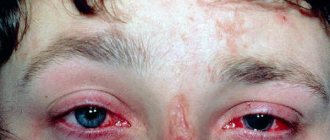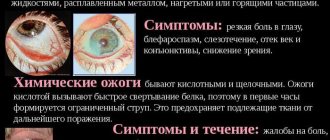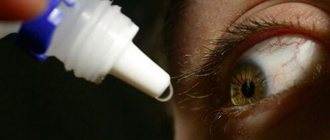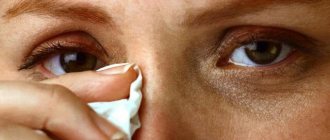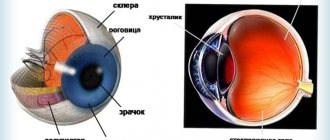An eye burn from alkali is one of the most dangerous types of eye injuries that can occur. If alkali gets into the eyes, a chemical burn occurs.
When alkali gets on the mucous membrane of the eyes or on the skin, both around the eyes and on other parts of the body, severe tissue damage occurs, followed by penetration of the reagent into the deeper layers of the mucous membrane or skin. The degree of damage depends on the time of exposure to alkali. The alkaline reagent instantly, in a few minutes, penetrates into the anterior and posterior chambers of the eye through the cornea, the cornea and iris are injured, the outflow of intraocular fluid is disrupted, and the lens is damaged.
In other words, the damaging effect affects almost all structures of the eye. The proteins dissolve, the damage goes both inward and outward. With an alkali burn, the pain is less pronounced than with an acid burn, but do not underestimate the extent of the damage. It is difficult to remove alkali that has penetrated deeply; the effect takes longer and can last up to several days; the degree of damage is determined after the burn.
In case of burns with alkali, the injury can be domestic or industrial. The most dangerous injury from an alkaline reagent occurs in production conditions, since highly concentrated solutions and toxic substances are used in enterprises or factories; such an injury can have very negative consequences for a person. If an alkaline reagent gets on the mucous membrane of the eyes, on the skin around the eyes, timely assistance is an important step, otherwise the person may lose vision forever.
Therefore, it is important for enterprises to observe safety precautions when working with toxic and highly concentrated substances. With regard to a domestic injury, everything is a little simpler, but this does not make it any less dangerous. The consequences of an injury at home are milder than at work, since in everyday life a person deals with a certain and, in most cases, permissible concentration of substances. But, despite this, a chemical burn of the eye caused by alkali at home is also extremely dangerous and can lead to loss of vision, therefore, if alkali gets into the eyes, you should immediately seek help from a specialized institution.
You may be interested in Lens Anomalies
Eye burns from acids and alkalis are severe, difficult to treat and, as a rule, treatment is very long and not without consequences. Emergency assistance for an eye burn with alkali should follow within minutes, even seconds after the injury, and after first aid has been provided, an ambulance should be called. But after an ambulance has already been called, it is necessary to continue providing emergency care. It is precisely this point that we will pay attention to in this article, so that, God forbid, of course, you encounter such a case, you know what needs to be done.
Symptoms
The initial and mild signs of such burns are redness and burning of the mucous membrane. With severe lesions, blepharospasm may develop - the person does not wash his eyes open. Associated symptoms also appear:
- sensitivity to light;
- blurred vision;
- loss of visual acuity;
- swelling;
- change in the shade of the mucous membrane;
- the occurrence of erosions and scars.
In severe cases, a chemical burn can lead to the development of cataracts and glaucoma. In the absence of drug therapy, gradual development of subatrophy is often observed. In this case, the eyeball dies. This process is irreversible.
In everyday life, burns can be caused by cosmetic procedures or exposure to detergents and alcohol. Therefore, before use, you must carefully study the instructions for use.
Burns of this type have several degrees of damage. Each of them is accompanied by characteristic symptoms.
In the first and mildest degree, the following symptoms occur:
- severe pain syndrome;
- blurred vision;
- redness;
- swelling of the conjunctiva;
- burning.
The second degree is accompanied by the following symptoms:
- sharp and constant pain (if affected by alkali, it subsides);
- decreased vision;
- the eyelids become blistered;
- erosive damage to the conjunctiva, cornea (later it can lead to detachment).
In case of third degree damage, the following is observed:
- necrosis;
- edema;
- pale color of the eyelids and conjunctiva;
- severe blurred vision;
- matte color of the cornea.
The fourth stage is the most difficult. Complete or partial loss of vision is added to the characteristic symptoms. The biggest danger is complete loss of vision.
Features of burns
Causes and types
Ophthalmologists believe that one of the main causes of burns in the visual organs is the effect of fire smoke on the mucous membrane. The problem can also be a consequence of gas formations entering the atmosphere.
Such damage to the mucous membrane of the eye occurs quite often, and can lead to serious complications, including loss of vision, if the person is not promptly provided with help and treated using various medications. Burns can occur during welding work or during prolonged exposure to the open sun, as a result of which the eyes are exposed to ultraviolet rays.
In case of eye burns, it is better to consult a doctor as soon as possible, since medications and other therapeutic measures are selected individually, based on the type and severity of the injury. In medicine, such eye injuries differ in location into the following:
Ophthalmologists have a classification based on the location of the damage.
- cornea;
- eyelids;
- conjunctiva;
- retina;
- lens;
- choroid plexuses.
The patient may experience minor eye burns, which in 100% of cases can be completely cured with eye drops. But there are also more severe stages of pathology, presented in the table:
| Degree | Peculiarity |
| 1 | The skin and mucous membranes turn red |
| Vision remains normal, temporary lacrimation may occur | |
| 2 | The superficial layers of the epidermis of the eyelid are damaged |
| The patient's burnt eye becomes swollen, red, and begins to water heavily. | |
| The cornea becomes uneven and cloudy | |
| 3 | Necrotic processes in the conjunctiva and nearby ocular tissues |
| Drying of the cornea and possible development of iridocyclitis and cataracts | |
| The damaged surface does not exceed 50% | |
| 4 | Deep necrosis and charring of the conjunctiva and sclera |
| The burn in most cases leads to uveitis, cataracts and glaucoma |
Alarming symptoms
First aid is to use local analgesics to relieve pain.
A patient with a burn needs to be prescribed pain-relieving eye drops as soon as possible, since he experiences severe pain that negatively affects visual function. If there is a problem, a person is also bothered by other symptoms:
- increased lacrimation;
- stabbing pain syndrome;
- redness of the eyes;
- swelling in the eyelid area;
- movement of the eyeballs accompanied by pain;
- feeling of sand in the visual organs;
- fear of bright light;
- blepharospasm.
If eye drops are not prescribed in time after welding or when receiving other burns, the patient’s iris tissue and ciliary body are damaged, which leads to the progression of iritis and iridocyclitis. A severe form of the lesion provokes clouding of the lens, disruption of the integrity of the choroid plexus and retina. In most patients, with a large area of eye burn, secondary glaucoma occurs, in which there is a high probability of infection and the development of endophthalmitis and panophthalmitis.
First aid - what to do
It is useful for every person to know what to do in case of a chemical burn to the eyes. Help is provided in several stages:
- First of all, you need to urgently rinse the affected eye. To do this, make a weak saline solution or potassium permanganate diluted in water. They have an antiseptic effect. It’s just important to take into account that they must be applied no later than 30 minutes from the moment of the burn. If it is not possible to prepare a solution, then rinse the eyes with plain water.
- When there is definitely a substance that caused the swelling, it should be removed. If it is an alkali, then it can be eliminated with a solution of vinegar, water and boric acid. You will need a few drops per 0.5 liters of water. If the burn is caused by acids, then the mucous membrane is treated with a mild soda solution.
- To avoid infection, use antiseptic eye drops.
When all procedures are completed, you need to cover the affected eye with a clean bandage. It is advisable to give the victim a sedative and call an ambulance. Since such manipulations do not allow complications to develop. The patient needs drug therapy, which is determined by the doctor.
It depends on the degree of damage and the general condition of the victim.
Pharmacological properties
Zinc eye drops have an antiseptic effect.
Zinc in combination with a small amount of boric acid has an anti-inflammatory effect. This component is an antiseptic. Zinc sulfate is obtained by processing sulfuric acid and zinc. To create eye drops, you need to obtain a certain concentration of the active substance. In the production of the drug, a hydrolysis reaction is used. Zinc sulfate interacts with proteins; the result is the formation of albumin. Such reactions make it possible to enhance the drying, astringent, and antiseptic effect. The coagulation process causes the proteins of microorganisms to coagulate and subsequently die.
The eye drop solution has a combined composition, which determines its properties. Zinc sulfate has a drying, astringent, antiseptic, and local anti-inflammatory effect. Boric acid is also an antiseptic. Capable of accumulating in tissues.
Allergic reactions with irritation and pain in the eyes.
No data.
Treatment
With such lesions, the victim needs drug therapy. The first step is to remove as much of the chemical as possible. The doctor determines visual acuity, the degree of damage to the eyelids and conjunctiva. Taking these indicators into account, painkillers, antiseptics, and healing drugs are prescribed.
In severe cases, hospitalization is required. The victim is prescribed treatment with antibiotics and drugs for regeneration of the mucous membrane. Additionally, you should take anti-inflammatory medications. Washing can be done with chamomile decoctions. It has an antibacterial effect.
First aid for acid or alkali burns
Emergency care for eye burns from alkali is provided immediately, since the chemical must be neutralized as quickly as possible. The antagonist of alkali is an acid, so the least dangerous agent for them is used to wash the eyes - a solution of boric acid.
The procedure for providing first aid for alkaline burns is as follows:
- Carefully remove any chemical residue from the eyelids and surrounding skin.
- Rinse eyes with clean water to remove traces of alkali. You can use a gauze pad, a piece of cotton wool or a bandage. In case of extensive damage, jet rinsing from a glass or any other container is permissible. The eyes must be open. It is important to wash out all the lye, so it is recommended to rinse for up to a quarter of an hour.
- Neutralize the remaining alkali by washing with a 2% boric acid solution.
- Apply a dry, sterile bandage to your eyes.
- Since eye lesions cause very severe pain, it is recommended to give the victim a painkiller.
It is also necessary to provide low lighting in the room where the patient is, since severe photophobia develops when the eyes are damaged.
If you don’t have boric acid at hand, you can simply rinse with clean water, saline solution, Ringer’s solution, or even regular milk. It is important to do this as quickly and efficiently as possible, since the alkali remaining in the eye will continue to corrode the mucous membranes and cornea, causing deep damage.
Contraindications
In case of a chemical burn of the conjunctiva and eyes, first aid must be provided to the victim. This will help eliminate the harmful substance and prevent the development of complications. An inexperienced person may make mistakes in carrying out such manipulations. In case of such lesions, it is strictly prohibited:
- eye rubbing;
- allow bubbles to burst;
- use eye drops;
- use alcoholic substances for processing;
- use healing agents without first washing the eyes.
It is worth considering that burns caused by lime or sulfuric acid should not be washed with water. Eye drops are not used for damage caused by glue. Every person will find this information useful. The danger and risk of such damage exists not only in production, but also in everyday life. If you correctly provide assistance to the victim, then in most cases this situation will end happily.
List of popular means
One of the popular treatments for injured eyes is Tsipromed.
Treatment of burns and their prevention can be carried out using various eye drops, which create a protective coating and prevent serious damage to the mucous membrane. The following medications are often prescribed to patients:
- "Tsipromed";
- "Floxal";
- "Normax";
- "Dexamethasone";
- "Emoxipin";
- "Derinat";
- "Vitasik" and others.
Leading ophthalmologists in Moscow strongly recommend that patients who receive a burn or the slightest eye injury contact the clinic, where specialists will select certain medications and modern methods of therapy.
When a person develops symptoms of an eye burn, you should not try to eliminate them yourself, using drops and other medications at your discretion. If there is a problem, contact an ophthalmologist, who will assess the severity of the disorder and select the necessary treatment measures. In most cases, with a mild or moderate burn, with properly selected eye drops, it is possible to completely get rid of the damage and stabilize visual function. If the drugs are selected incorrectly and therapy is delayed, severe complications cannot be avoided, including glaucoma or complete loss of vision.
Complications and consequences
This type of damage is a serious injury that can lead to complete loss of vision. Chemicals can affect the visual organs in different ways. The consequences are minor and irreversible. Acid damage is accompanied by severe pain.
In some cases, this can cause painful shock. If you provide timely assistance to the injured person, you can avoid serious consequences.
Burns caused by alkali are considered very dangerous. Such substances can change the structure of the eyes, leading to necrosis and the development of ophthalmotonus. Complications that can be caused by any substances:
- swelling;
- conjunctivitis;
- erosive lesion;
- inflammation;
- cataract.
An increase in ophthalmotonus is often observed. Severe consequences can occur several weeks after the burn:
- glaucoma;
- cataract;
- the appearance of scars on the conjunctiva;
- mucosal ulcers.
In case of chemical burns to the eyes, you should remain calm. Rash actions can aggravate the situation. If the injured person cannot calm down, then he should be given a sedative. This medicine won't do any harm.
Indications and contraindications for use
The drug is used to treat conjunctivitis caused by microbes. Zinc sulfate drops are recommended for blepharitis.
with anterior marginal blepharitis (if this disease progresses, the eyelids become inflamed at the edges); with posterior marginal blepharitis (the disease is accompanied by damage to the meibomian glands located in the eyelid, the pathological reaction involves the cornea and conjunctiva); with the progression of blepharitis caused by fungi;
lacrimation; sensation of a foreign body near the cornea; hyperemia of the mucous membrane of the eye; photophobia; purulent process.
As noted, zinc sulfate is prescribed when a foreign body gets into the eye. Let's consider the testimony.
Contact with the mucous membrane of the eye by plastic particles. This problem does not lead to illness: plastic is relatively safe for the eyes. Penetration of iron particles into the mucosa. Here things are different: iron becomes the cause of ophthalmic toxic diseases. There are cases when inflammation becomes chronic.
Visual acuity decreases; the result may be functional death of the eye. The medicine zinc sulfate is prescribed if a copper particle gets into the eye. Untimely treatment in this case leads to toxic damage. Getting a foreign body into the eye is fraught with consequences. Siderosis and chalcosis may develop.
Before using the medicine, you need to remove the cap from the package. Using scissors, you should carefully cut off the membrane, which is located on the neck of the housing. The threaded part must remain intact. Next, you need to turn the dropper body over: the neck is at the bottom. Zinc sulfate drops are made in such a way that they can be used without a pipette.
Zinc sulfate is not recommended for people who are allergic to zinc salts. The use of contact lenses is contraindicated. If you cannot do without this medication, you need to temporarily abandon the lenses (replace with glasses). Some people are hypersensitive to the components of zinc sulfate. In this case, the product is replaced with another. The drug is not prescribed to patients with impaired renal and liver function. Dry eye syndrome is also a contraindication.
For small children
For a child under 18 years of age, another treatment is recommended.
We suggest you read: Fighting ants in an apartment with boric acid
Blepharitis. Conjunctivitis. Prevention of bacterial infection in case of foreign bodies entering the conjunctival cavity.
Individual hypersensitivity. Dry eye syndrome. Impaired liver and kidney function. Pregnancy and lactation period. Age up to 18 years.
If you do not know what to do if alkali gets into your eyes, do not try to instill the first drops you find into the victim, this can be very dangerous. It is equally risky to try to wipe off the lye with dry things - a towel, handkerchiefs, especially rubbing the substance on the skin. This can only aggravate the damage and spread the “chemistry” over the skin.
If a piece or drop of whitewash, lime, or plaster gets on your skin or eyes, you must first carefully remove it with some object and then rinse the area. If you don’t do this and immediately start rinsing, the alkaline substance will be spread over a large area and the burn will only increase.
Forecast
A chemical burn is a serious and emergency situation that requires immediate attention. Despite this, the prognosis in most cases is favorable. The main thing is not to panic and take all necessary measures.
Then doctors are able to completely preserve and restore the functions of the visual organs.
In industries with an increased risk of danger, workers undergo special training. Therefore, most people know what to do in an emergency. If there is no one near the victim, you must definitely call for help. The damage may cause blurred vision or an inability to open the eyelids. Therefore, the patient cannot help himself.
There are cases when timely, high-quality care cannot protect against the formation of a cataract on the injured eye. In addition, there is always a risk of atrophy of the eyeball, and subsequently loss of its mobility.
It is worth considering that preventing such damage is much easier than treating it. Complications can be very serious. Despite all the necessary auxiliary manipulations, you can lose your vision. It all depends on the substance that caused the burn and the extent of its damage.
When working with household products, it is important to prevent them from getting into your eyes. At enterprises, workers must be given protective uniforms and glasses. Especially those who come into contact with chemicals. Also, enterprises must have instructions for work and first aid rules.
If the employer does not provide the necessary protective equipment, this is considered a gross violation. Therefore, when working with chemicals and hazardous substances, this information must be taken into account. A person must be aware of the work rules and follow safety precautions.
Chemical solution got into eye - CyberPedia
Immediately rinse eyes and eyelids with plenty of running water
It is best to sit the victim near a sink, tilt his head back or to the side of the injured eye. Be sure to open your eyelids and rinse with running water for at least 20-30 minutes
If the solution gets into both eyes, rinse both eyes at the same time. If the solution gets on the whole face and other parts of the body, then, in addition to washing the eyes, the victim needs to take a shower
After rinsing, immediately contact a specialized emergency room
IMPORTANT! If quicklime powder gets into the eye, it is ABSOLUTELY NOT possible to rinse your eyes until the crystals are completely removed from the surface of the eyelids and eyeball (when interacting with water, lime begins to produce heat and the burn can only intensify). In this case, try to completely remove the crystals with a dry, clean cloth, and then thoroughly rinse the damaged tissue with running water and contact a specialized emergency room.
Burn of eyelids and eyes by flame
Remove dirt from the skin of the eyelids, wipe the skin of the eyelids with alcohol (be careful not to get alcohol into the eye!)
Place dry ice on your eyes (for example, ice in a bag wrapped in a clean napkin)
Apply antibacterial ointment (for example, tetracycline 1%) to the skin of the eyelids and behind the eyelid.
Contact a specialized emergency room
Eye burns from ultraviolet rays (in a solarium, during prolonged work near a quartz lamp, welding work)
Darken the room, as the victim will usually develop severe photophobia
Place an antibacterial ointment (for example, tetracycline 1%) behind the eyelid
Place dry ice on your eyes (for example, ice in a bag wrapped in a clean napkin)
Give a pain reliever (eg Pentalgin, Solpadeine, Nurofen)
If the pain does not go away within a few hours, go to a specialized emergency room.
retinal burn
Bleeding from the eye
Typically associated with severe contusion or penetrating eye injuries
Place antibacterial drops into the eye (for example, Albucid 20%, Levomycetin 0.25% or Vitabact 0.05%)
Cover your eye with a clean (preferably sterile) bandage. DO NOT PRESSURE ON YOUR EYES!
Contact a specialized emergency room immediately
specialized assistance
Contact a specialized emergency room immediately
Epilepsy
Burns
The task of the first aid provider is to apply a dry aseptic dressing in order to prevent infection of the burn injury. For dressing, use a sterile bandage or an individual bag. If these products are not available, you can use a simple cotton cloth, ironed or moistened with an antiseptic. Antiseptic solutions can be ethyl alcohol, potassium permanganate, ethacridine lactate (rivanol), vodka.
What not to do:
1. Touch the burn with your hands;
2. Puncture the blister;
3. Wash the burn injury;
4. Tear off stuck clothes;
5. Lubricate the burn with oil, fat, petroleum jelly (this will lead to infection and complicate the initial surgical treatment of the injury). For 2nd, 3rd and 4th degree burns, shock quickly sets in. The victim must be laid down and covered, because if thermoregulation is disrupted, he will shiver. It is necessary to give the patient plenty of fluids to replenish the loss of circulating blood volume. To relieve pain, narcotic analgesics (promedol, morphine, omnopon) are used. To determine the area of the burn, the palm rule is most often used:
1 palm of the victim = 1% of the body,
a burn of the respiratory tract is taken to be 30% of a 1st degree burn.
For extensive burns, the patient is wrapped in a clean sheet, the injured area is kept immobilized (immobilization), and transported to a medical facility.
When ensuring immobilization, you need to ensure that the skin in the area of damage is as stretched as possible (for example, if the inner surface of the elbow is burned, fix the arm in an extended position, if the outer surface is bent). Great care must be taken during transportation. In a medical institution, the victim will undergo initial treatment of the burn, eliminate shock, administer anti-tetanus serum, and prescribe local and general treatment.
cyberpedia.su
Prevention
In most cases, burns of this type occur in people who work with chemicals in production. The main reason for the defeat is a violation of technical processes and their safety. When working with hazardous compounds, you must use special protective glasses and gloves. It is often necessary to use a protective mask to prevent fumes and chemicals from damaging the respiratory system.
In domestic conditions, it is also necessary to use protective elements when working with chemicals. Before use, be sure to study the instructions and composition of the product. With proper use, the risk of developing undesirable consequences is reduced. Any household products must be strictly stored in places that are inaccessible to children. If the substance gets into your eyes, you must immediately provide first aid and consult a doctor. In most cases, drug therapy lasts 3-7 days.
If a person has already experienced a burn, he is prescribed appropriate treatment. It is worth noting that in such cases it will also be necessary to prevent complications. It is very important to constantly monitor intraocular pressure. Its indicators may indicate the development of severe complications. For example: cataracts, glaucoma. The main prevention is to prevent the occurrence of burns. The damage may have irreversible consequences. The duration of vision restoration depends on the degree of eye damage.
When are medications needed?
In the absence of necessary therapy, complete loss of vision may occur.
Eye drops for welding and other burns are used not only for medicinal but also for preventive purposes. It is mandatory to use ophthalmic agents in case of occlusion of the central retinal artery and in case of exposure to chemicals on the eye. If treatment is not carried out in time, the person may become completely blind. Therapy using eye drops is possible for any degree of burns, but the choice of drug should remain with the veterinarian.
If a person is burned by glue or other chemicals, he should immediately contact a veterinarian. When the burn is mild and the patient feels well, treatment can be done at home using eye drops with a calming, regenerating and analgesic effect. If pain and other unpleasant symptoms persist for 3 days, and a rapid decline in visual function is observed, then you cannot postpone a visit to a specialist and you need to contact him as soon as possible. An ophthalmologist can prescribe eye drops for “bunnies” after welding and for other burns, thanks to which it is possible to prevent infection and other complications.
